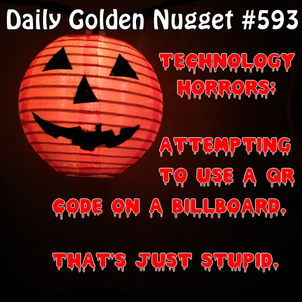 Today I'd like to tell you give you some additional warnings about QR code usage. QR codes are those square barcodes that look like a bunch of small dots. Many companies have incorrectly tried to use them in their advertising. Keeping with the theme of today, there are times when you should use QR codes and there are times when you should simply scream in horror at the waste of time and money that some marketing companies would suggest.
Today I'd like to tell you give you some additional warnings about QR code usage. QR codes are those square barcodes that look like a bunch of small dots. Many companies have incorrectly tried to use them in their advertising. Keeping with the theme of today, there are times when you should use QR codes and there are times when you should simply scream in horror at the waste of time and money that some marketing companies would suggest.I've seen such horrors, and I can't believe that large companies actually spent money on these marketing ideas without thinking through the QR code technology.
The biggest waste of money I've seen in person was the large billboard campaign by Asus and Intel in New York City. Ausu positioned several very large billboards around the city, including one in Time Square, with the headline "In Search of Incredible." The billboards also had an incredibly large QR code on it. When standing in front of the billboard in person the QR code looked huge, but the iPhone and Android smartphones I tested at the time were unable to read the code. Even in bumper to bumper traffic, using your phone to scan a QR code is probably the last thing on your mind.
In order to see the QR code on these billboards I had to stand across the street from them. From that distance, the codes themselves appeared very small through the Android and iPhone camera lens. The QR code apps on the Android and iPhone are not designed to read codes from that distance, which made this a marketing failure.
I've also seen QR codes on other billboards on busy highways, which doesn't make any sense at all. Aside from the fact that you can't take a photo of a QR code from more than a few feet away, there's also no way a driver or a passenger could successfully take a clear photo of a QR code while speeding down the road.
From my own testing I've found that a QR code would have to be at least 3 feet square in order to successfully scan at 9 feet away. Even without complicated math, you should be able to tell that a QR code would need to be taller than a 2 story house from across a street. Don't ever let a marketing agency suggest QR codes on billboards; it's a waste of your money.
I've also noticed the strange attempted use of QR codes on websites, as Facebook photos, as Google+ icons, in TV commercials, and in YouTube videos. At first this might seem like a reasonable idea because it's a "Quick Response" way to allow people to move from their desktop computer to their mobile device, but it's not that easy.
I don't want to get technical, but I do have to bring up a little bit of science to explain why QR codes are silly to use on a computer screen. Every TV, digital sign, or computer screen flickers very quickly as electricity pulses through it. The human eye can't see these pulses because they are very fast, but smartphones can see them. To a smartphone these pulses often cause dark blotches or wavy lines in the photographs which would prevent a QR code from being understood.
I've tested various size QR codes on a computer screen using different computers and different types of Android phones and different iPhones. The result is always the same; in that I can eventually get the QR code to scan but the QR code needs to be very crisp, and it takes several tries. In other words there's nothing "Quick Response" about it. It always turns out to be faster to type the web address on the smartphone than to get annoyed by the technology.
So if you'd like to avoid the foolhardy attempts at QR code marketing, stay away from using them on large billboards and in any type of digital marketing.
QR codes are intended to bridge the gap between the real world and cyberspace. Don't try to bridge the gap between desktop cyberspace and mobile cyberspace with them.








